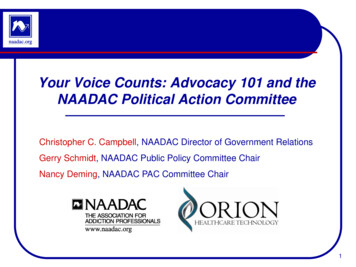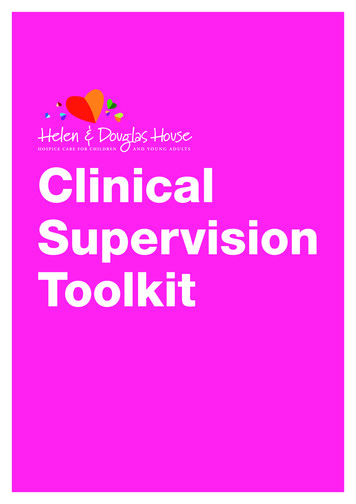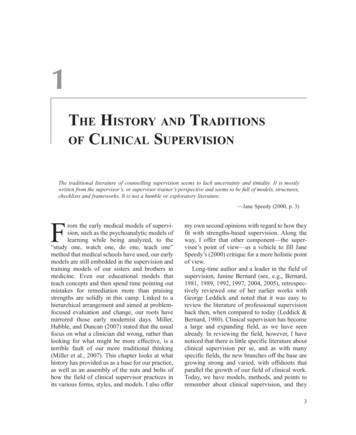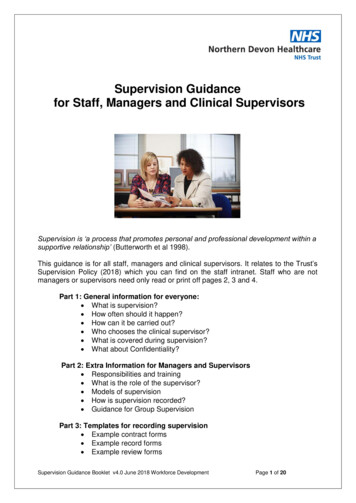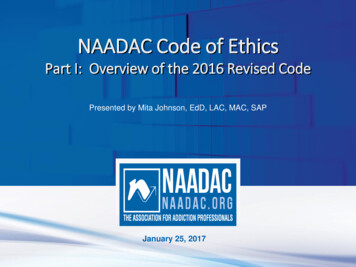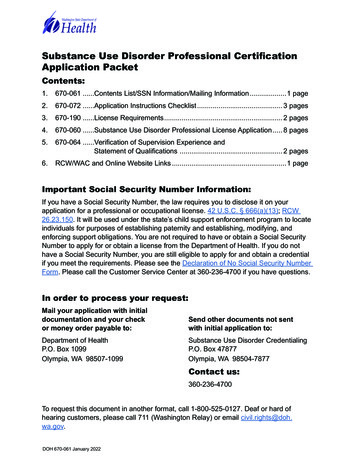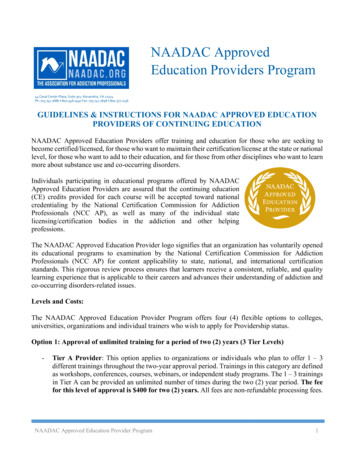
Transcription
CLINICAL SUPERVISION:AN OVERVIEW OF FUNCTIONS,PROCESSES AND METHODOLOGYByThomas G. Durham, PhDNAADAC, the Association for Addiction Professionals44 Canal Center Plaza, Suite 301, Alexandria, VA 22314Ph. 703.741.7686 800.548.0497 Fax: 703.741.7698Email: naadac@naadac.org Web: www.naadac.orgCLINICAL SUPERVISION: AN OVERVIEW OF FUNCTIONS, PROCESSES AND METHODOLOGY[1]
DISCLAIMERThe purpose of Clinical Supervision: An Overview of Functions, Processes and Methodology is to provide a compendiumof material that offers a general overview of information pertaining to clinical supervision in the addiction treatmentprofession and for other mental health professionals. The materials contained herein are intended to compile an overviewof research and provide a comprehensive knowledge base for clinicians who wish to expand their knowledge in clinicalsupervision. This manual is NOT all-inclusive or in sufficient detail to ensure success in certification/licensure exams butcan be used as a resource to enhance overall understanding of clinical supervision in preparation for exams. As an adjunctto previously received didactic and experiential training in clinical supervision, this manual is also intended to assistthe aspiring clinical supervisor in exploring concepts, theories, techniques and principles of this complex and dynamicundertaking.Care has been taken to confirm the accuracy of the information presented and to describe generally accepted science.However, the author, NAADAC, editors and publishers are not responsible for errors or omissions or for any consequencesfrom the application of the information presented in this manual and make no warranty, express or implied, with respectto the contents of this publication.Published in 2019 byNAADAC, the Association for Addiction Professionals44 Canal Center Plaza, Suite 301, Alexandria, VA 22314This publication was prepared by NAADAC, the Association for Addiction Professionals. All material appearing in thispublication, except taken directly from public domain, is copyrighted and may not be reproduced or copied withoutpermission from NAADAC. For more information on obtaining additional copies or bulk orders, email naadac@naadac.org.Printed September 2019.[2]CLINICAL SUPERVISION: AN OVERVIEW OF FUNCTIONS, PROCESSES AND METHODOLOGY
A SPECIAL THANK YOUNAADAC, the Association for Addiction Professionals, understands the need for continuous education andstrive to provide addiction-focused professionals the latest training to remain knowledgeable and pursue bestpractices for clients. The addiction profession is constantly changing to reflect new research and new understandingof the populations we serve. As a result, NAADAC is providing addiction professionals comprehensive education onclinical supervision.This manual has been developed as a resource for addiction-focused professionals who work as clinicalsupervisors. Consistent clinical supervision has long been understood as a primary indicator of quality care. Whenprofessional helpers receive structured and consistent clinical supervision accuracy to regulations improves, patientsatisfaction increases, quality and safety measures are more likely adhered to, and accountability becomes anexpected norm.This manual is intended to be a resource for professionals seeking to expand their knowledge of the functions,processes, methodology, and best practices in clinical supervision. The concept of clinical supervision will bedefined, along with updated research on the effectiveness, methods, and techniques of clinical supervision specificto the addiction profession. Clinical Supervision strategy, structure, evidence-based models, and ethics will also bedescribed.Thomas G. Durham, PhD is the primary author of the Clinical Supervision Workbook. Many other writers andconsultants volunteered their time and knowledge during the development of the training materials. NAADAC wouldlike to extend its sincerest appreciation to the numerous contributors to this project: Thomas Durham, MichaelDeMolina, Marty Harding, Sue Hoisington, Jim Holder, Donovan Kuehn, Rose Maire, Kaylene McElfresh, RichardSolly, Gerry Schmidt, Misti Storie, Jessica Gleason, Kristin Hamilton, Samson Teklemariam, Cynthia Moreno Tuohyand Mary Woods. This project could not have been completed without the many hours of brainstorming, researching,writing, reviewing and editing so this product could be a significant contribution to the addiction profession.NAADAC’s Clinical Supervision: An Overview of Functions, Processes, and Methodology is only one ofmany planned educational projects geared at providing comprehensive and unbiased education to the addictionprofession. NAADAC recognizes you have a choice in education providers, and we are delighted you have chosen totake part in this educational experience and build your toolbox of treatment resources. Thank you for your dedicationto the addiction profession!Together, we can and are making a difference!Sincerely,Diane Sevening, EdD, LAC, MACPresidentNAADAC, the Association for Addiction ProfessionalsCLINICAL SUPERVISION: AN OVERVIEW OF FUNCTIONS, PROCESSES AND METHODOLOGY[3]
DEDICATIONNAADAC dedicates this manual to the late David J. Powell, PhD, whose model of clinicalsupervision has been held up as the quintessential road map for professionalism in supervisorypractice. His supervision, mentorship and friendship to the primary author for nearly 30years inspired the development of this manual. Thousands of addiction professionals havebenefited from his expertise, leadership and guidance and have ultimately touched the livesof an inordinate amount of clientele during his professional career and beyond. It is ourhope that, through this manual, the contributions of Dr. Powell will continue to enhance themotivation and professional growth of those who use it.Sincerely,Thomas G. Durham, PhDPrimary AuthorClinical Supervision: An Overview of Functions, Processes and MethodologyNAADAC, the Association for Addiction ProfessionalsLike many of us in the Addiction Profession, I consider the late David Powell the forefatherof clinical supervision and have used his materials as a guideline light for decades. I washonored to work with Dr. Powell as a clinical supervisor in the US Navy PreceptorshipProgram, conducting trainings in China, and discussing the future landscape of addictionpractice. His devotion to the addiction profession is something many of those who workedwith him, including myself and the primary author of this manual, Thomas G. Durham, PhD,have worked to emulate. Thank you, Tom Durham, for your great work with this manualand your loyalty to David and the addiction profession. You have taken David Powell’sfoundational work to a heightened level.Sincerely,Cynthia Moreno Tuohy, BSW, NCAC II, CDC III, SAPExecutive DirectorNAADAC, the Association for Addiction Professionals[4]CLINICAL SUPERVISION: AN OVERVIEW OF FUNCTIONS, PROCESSES AND METHODOLOGY
CONTENTSPREFACE .7CHAPTER ONE - INTRODUCTION .PRIMARY ASSUMPTIONSWHAT IS THE STATE OF CLINICAL SUPERVISION TODAYTIME AND STRESS MANAGEMENTDUAL ROLES OF CLINICAL SUPERVISORSTECHNOLOGY-BASED CLINICAL SUPERVISIONSUMMARY10101616161717CHAPTER TWO – THE SCOPE OF CLINICAL SUEPRVISION.TRADITIONAL DEFINITIONSPUBLISHED DEFINITIONSROLES OF CLINICAL SUPERVISORSGOALS FOR CLINICAL SUPERVISIONCOMPETENCIES OF CLINICAL SUPERVISORSQUALITIES OF EFFECTIVE CLINICAL SUPERVISORSSUMMARY1820212526272828CHAPTER THREE – THE SUPERVISORY RELATIONSHIP.DEVELOMENTAL FACTORSTHE SUPERVISORY ALLIANCETHE SUPERVISORY RELATIONSHIP AS A MULTI-PERSON SYSTEMEMPOWERMENT AND GROWTHCULTURAL HUMILITY AND DIVERSE VALUE SYSTEMSSUMMARY29303132333638CHAPTER FOUR – MODELS AND THEORIES OF SUPERVISION .PSYCHOTHERAPY-BASED MODELS OF CLINICAL SUPERVISIONTHE DEVELOPMENTAL APPROACH TO CLINICAL SUPERVISIONSUPERVISION PROCESS MODELSSUMMARY3940444446CHAPTER FIVE – LEGAL AND ETHICAL ISSUES IN SUPERVISION .LEGAL ISSUES IN SUPERVISIONETHICAL ISSUES IN SUPERVISIONSUMMARY48495356CHAPTER SIX – EVALUATING AND MONITORING COUNSELOR PERFORMANCE . 58THE COLLABORATIVE RELATIONSHIP IN THE EVALUATION PROCESS59ANXIETY AS A FACTOR IN THE EVALUATION PROCESS60METHODS OF EVALUATION61DEVELOPING GOALS65GIVING FEEDBACK65SUMMARY66CLINICAL SUPERVISION: AN OVERVIEW OF FUNCTIONS, PROCESSES AND METHODOLOGY[5]
CHAPTER SEVEN – METHODS AND APPROACHES IN SUPERVISION .INDIVIDUAL SUPERVISIONGROUP SUPERVISIONFOSTERING MOTIVATIONTECHNOLOGY–BASED CLINICAL SUPERVISIONSUMMARY686971737474CHAPTER EIGHT – OBSERVATION AND LIVE SUPERVISION .ONE-WAY MIRROR OR LIVE VIDEO MONITORINGIN-SESSION OBSERVATIONTHE USE OF AUDIO AND VIDEO TAPESSUMMARY7677787981CHAPTER NINE – STAGES OF SUPERVISION . 83THE BEGINNING STAGE OF CLINICAL SUPERVISION84THE INTERMEDIATE STAGE OF CLINICAL SUPERVISION87THE ADVANCED STAGE OF CLINICAL SUPERVISION91SUMMARY94CHAPTER TEN – TECHNOLOGY-BASED CLINICAL SUPERVISION . 96TYPES OF TECHNOLOGY-BASED CLINICAL SUPERVISION97KEY BENEFITS OF TECHNOLOGY-BASED CLINICAL SUPERVISION99LEGAL AND ETHICAL ISSUES100ACCESSIBILITY TO TECHNOLOGY-BASED CLINICAL SUPERVISION101SUMMARY102REFERENCES . 104APPENDIX . 108GLOSSARY OF TERMS . 117[6]CLINICAL SUPERVISION: AN OVERVIEW OF FUNCTIONS, PROCESSES AND METHODOLOGY
PREFACECLINICAL SUPERVISION: AN OVERVIEW OF FUNCTIONS, PROCESSES AND METHODOLOGY[7]
Clinical supervision is a mutual endeavor enhanced by a trusting bi-directional relationship that leads toprofessional development and enhanced client care through mentoring, guidance and clinical oversight. As a centrallearning experience, it becomes a process of conceptualized growth and, when effective, it involves much more thanmonitoring a counselor’s work.Clinical supervision is emerging as a distinct professional specialty, yet most supervisors learn how to supervisebased on their own experience as a supervisee. Though clinical supervision has long been practiced in the behavioralhealth professions, most research and training in this subspecialty has occurred during the last 30 years. Whereascounseling and psychotherapy have had the benefit of much research-based literature from which to draw, therehas been a dearth of research on clinical supervision. Despite such scarcity, Bernard and Goodyear (2018), intheir seminal text on clinical supervision, assert that all mental health professionals must acquire skills in clinicalsupervision since virtually all who make a career in counseling will eventually supervise others. NAADAC supportsthe assertion that all addiction professionals must acquire skills in clinical supervision since many who make acareer in addiction specific counseling will be called upon to supervise others.In today’s world of behavioral healthcare, programs, clinics, and counselors are held accountable in ways neverbefore experienced. New demands for cost containment have resulted in our constant search for innovative waysto provide treatment and clinical supervision. We have been asked to provide treatment in less time with fewerresources and have begun to explore new technologies in pursuit of the most effective and efficient means ofproviding client care. For example, the use of technology is currently being explored and perfected as a means ofreaching both clients and supervisees in remote or isolated areas (Barton, Roget, & Hartje, 2016). While the use oftechnology comes with many ethical questions relating to security and confidentiality, we must continue to exploreall means of improving the effectiveness of our services while staying within the bounds of ethical practice.Supervisors are tasked with carefully monitoring the services provided by counselors in an effort to seekassurance that service delivery maximizes each treatment opportunity. However, the downside of such monitoringpresents a risk of minimizing the supervisory relationship and professional growth of the supervisee. In fact, limitingsupervision to mere monitoring leaves the relationship perfunctory and hierarchical. The role of the supervisor mustexpand and many find themselves ill-equipped to deal with the many demands being placed on them.For those benefitting from supervision, a significant learning experience can result – no matter where they lie onthe continuum of professional development. As one strives for professional growth as a counselor, effective clinicalsupervision is a significant component of such progress. Such ongoing development, of course, is not only expectedof entry-level counselors, but of advanced clinicians as well. Clinical supervision involves professional guidance froman experienced teacher or mentor who transmits knowledge to broaden the supervisee’s perspective. In fact, a majorgoal of supervision is to equip the counselor with the ability to “self-supervise.” This is not to say one will eventuallycontinue without supervision, but it does support the goal that each counselor will gain confidence and a sense of[8]CLINICAL SUPERVISION: AN OVERVIEW OF FUNCTIONS, PROCESSES AND METHODOLOGY
autonomy as a clinician, thus gaining an ability to choose an effective course of action that is consistent with his orher own judgement or inclination (Corey, Haynes, Moulton, & Muratori, 2010).The knowledge that is transmitted in clinical supervision can be classified in two overlapping areas: researchbased theory and the supervisor’s own knowledge-based skills. The latter involves the supervisor’s own acquiredknowledge through his or her accumulated experience, training and supervision. However, how transmittedknowledge impacts a supervisee is also influenced by the supervisee’s own personality dynamics. This may includerelational or interpersonal dynamics, level of self-confidence and degree of self-understanding (Bernard & Goodyear,2018).Supervision is complex. Not only does it involve a modicum of teaching through the relationship with anexperienced clinician, it also brings all the dynamics of a patient into a relationship that has complexities of its own.The supervisory relationship also includes an evaluative role on the part of the supervisor. If the supervisor usesthis role to hold power over the supervisee by infusing elements of contest, confrontation and challenge in therelationship, tension and mistrust will result. On the other hand, a supervisor who shows support, encouragementand collaboration will inevitably foster a collegial spirit, a high level of trust and a passion to grow and learn (Bernard& Goodyear, 2018; Corey et al., 2010).This manual provides a resource for addiction and other mental health professionals in clinical supervision,whether or not they are already functioning as supervisors. To that end, it provides a comprehensive knowledgebase for clinicians who wish to expand their knowledge in clinical supervision. An as adjunct to previously receiveddidactic and experiential training in clinical supervision, this manual is also intended to assist the aspiring clinicalsupervisor in exploring concepts, theories, techniques and principles of this complex and dynamic undertaking.CLINICAL SUPERVISION: AN OVERVIEW OF FUNCTIONS, PROCESSES AND METHODOLOGY[9]
CHAPTER ONEINTRODUCTION[10]CLINICAL SUPERVISION: AN OVERVIEW OF FUNCTIONS, PROCESSES AND METHODOLOGY
Clinical supervision has become the primary means of training for addiction and mental health professionals.Most credentialing boards require several thousand hours of supervised work experience, whether part of a degreeprogram or outside of an academic experience. For most addiction professionals, supervision and training occurs onthe-job. Although many receive such supervised training in an academic setting or field placement, most addictionprofessionals rely on the guidance of an experienced clinical supervisor in their development toward mastery aseffective counselors (Campbell, 2006). If such guidance is lacking in supervisory expertise, counselors may struggle,experience unnecessary stress, or perhaps terminate their employment. Potentially talented counselors may be lostto the field; thus, contributing to staff turnover, a situation that many programs in the field are already experiencing.Primary AssumptionsThis training manual is based on eight primary assumptions that are discussed here. These assumptions forma philosophical foundation that are intertwined throughout the material presented in this document. They are asfollows:Relational Dynamics – The relationship between the supervisor and the supervisee becomes the foundationthat all work in supervision is based on. A productive and positive supervisory relationship is supported by manyas an essential component leading to effective counselor development and client care (Bernard & Goodyear, 2018;Corey, et al., 2010; Campbell, 2006). Like the clinical relationship, the power of the relationship is one of the mostsignificant influential factors in supervision. A working alliance between supervisee and supervisor is crucial to theeffectiveness of the relationship. Such alliance leads to a level of engagement that is necessary for a trusting bondmarked by positive rapport and a mutual desire to work together. Therefore, taking time to cultivate the relationshipwhile focusing on engagement becomes an initial step in developing a strong working alliance (Bernard & Goodyear,2018; Campbell, 2006). As noted by Bernard and Goodyear (2018), “the supervisory relationship is the pillar thatsupports everything else about supervision” (p. 86).Not unlike the clinical relationship where counselors explain to clients the process of therapy in order to reduceanxiety, it is essential that supervisors develop a successful relational experience. Supervisors must diligently build anunderstanding and concurrence with each supervisee with regards to expectations and professional developmentalneeds. In addition, supervisors can be instrumental in reducing anxiety and creating a safe environment to fostergrowth within the supervisory relationship (Campbell, 2006).It is important that supervisors take time during the developmental stages of the supervisory relationship toestablish the framework for supervision. As we will see later in Chapter Seven, taking a motivational interviewingapproach in establishing the relationship can not only assist in laying the important foundation for supervision, butit enhances the potential to develop a positive working alliance by reducing anxiety, creating trust, and overcomingany initial resistance to supervision.CLINICAL SUPERVISION: AN OVERVIEW OF FUNCTIONS, PROCESSES AND METHODOLOGY[11]
Direct Observation – Providing clinical supervision through direct observation (also known as “live supervision”)gives the supervisor a consistent and accurate picture of the counselor’s skill level while providing a forum forshaping skills through role modeling and on-the-spot input. Like a craftsman who guides an apprentice throughdemonstration and observation, the clinical supervisor is given an opportunity to foster an effective learning andgrowth experience for the counselor being observed.Direct observation of a supervisee’s work has the potential of increasing the supervisory alliance, principallythrough a mentoring and supportive relationship. This occurs through an increased level of involvement, in particularwhen the observation is accomplished by way of the supervisor doing co-therapy with the supervisee. Since theyare working together, with the opportunity for direct and immediate assistance (both during and after the session),there is great potential for reduced anxiety (about being observed) and an enhanced alliance between superviseeand supervisor (Bernard & Goodyear, 2018).As noted by Powell (2004), direct observation has the potential to become the cornerstone of effectivesupervision of addiction and mental health professionals as it provides a consistent and accurate picture of thesupervisee. Besides the potential of enhancing the supervisory alliance, being in the room with the counselor orobserving through any of a variety of means, greatly enhances the fidelity of the information about the supervisee’sskill and knowledge level (Powell, 2004). Meeting with the supervisee after the session provides a rich opportunityto discuss the session, explore interventions made (by the supervisor as well as co-therapist), and discuss howworking together was beneficial to the client.Finally, direct observation can include demonstrations by the supervisor – especially during co-therapy with aclient. Supervisors are able to constantly model professional behavior – in staff meetings, casual communicationswith clients and staff, and in clinical sessions. As a supervisor, you are constantly under the spotlight. Modelingand demonstrating clinical expertise is perhaps the most powerful and significant means of modeling therapeuticinterventions and behavior. Demonstration by the supervisor, whether with a client or during a supervisory role play,can have a secondary benefit by reducing burnout, enhancing motivation, and providing additional support for allstaff (Campbell, 2006). Direct observation will be explored further in Chapter Eight of the manual.Raising Counselor Self-Efficacy – An effective clinical supervisory working alliance has the potential of raisingself-efficacy among counselors, not only for those at the entry level but for those who may become discouraged,experience self-doubt or burnout at any level of professional growth. Described as an individual’s belief about hisor her level of capability to produce a desired level of performance, self-efficacy is domain-specific (Bernard &Goodyear, 2018). Thus, when we speak of self-efficacy in the domain of counseling, we are referring to one’s level ofbelief in his or her capability as a professional counselor.Clinical supervisors play a significant role in influencing counselor self-efficacy. Most supervisees have astrong need to feel (and appear) competent. Thus, the supervisory alliance and the methods and techniques usedto offer input to counselors on their work are crucial to the success of raising counselor self-efficacy. As we willsee in Chapter Four of this manual, there are several developmental models that demonstrate an oscillation inone’s level of self-efficacy as one moves through his or her developmental stages of growth (Bernard & Goodyear,2018; Stoltenberg & McNeill, 2010; Powell, 2004). In Chapter Six we explore specific means of performing formativeevaluations for supervisees. This will include not only the provision of effective feedback, but also the introduction ofconcepts known as feed up and feed forward that, along with taking a motivational interviewing approach, can bequite powerful in enhancing counselor self-efficacy (Fisher & Frey, 2007).Solution- and Strength-Based Supervision – As a narrative approach to supervision, solution-focusedsupervision is a strength-based attitude that emphasizes the creation of a reality constructed within one’s contextualenvironment. Grounded on the assumption that people can construct pathways to success, this approach focuseson creating visions of what is possible while acknowledging the supervisee’s strengths. Following the philosophyof Steve deShazer’s solution-focused therapy, this supervisory approach encourages the creation of solutionswithout dwelling on the “problem” (deShazer, 1994). Bernard and Goodyear (2018) provide an overview of solutionfocused supervision that includes identifying positive goals for the supervisee, exploring exceptions to difficulties[12]CLINICAL SUPERVISION: AN OVERVIEW OF FUNCTIONS, PROCESSES AND METHODOLOGY
and challenges, and processing positive changes that occur between supervisory sessions for both the superviseeand his/her client.Solution- and strength-based supervision also follows Powell’s philosophy that supervisees find theirown solutions while under the tutelage and guidance of a mentor (Powell, 2004). Solution-focused supervisionemphasizes that when supervisors dwell too much on the struggles a supervisee may be having, solutions can beoverlooked. By searching for exceptions to what the supervisee may be struggling with, the focus shifts from theproblem to the solution.Individualized, Needs-Based Model – As with the therapeutic approach with clients, understanding individualneeds is an essential element in clinical supervision. Since a major component of supervision is the promotion ofsupervisee growth and development, a needs-assessment, primarily based on the supervisee’s self-assessment, isa key factor in this effort. Self-discovery and self-exploration by the supervisee lead to empowerment, thus enablingthe supervisee to monitor his/her own performance (Corey et al., 2010). This self-discovery can be encouragedand monitored by the supervisor who, through this process, gains awareness of the individualized needs of thesupervisee.An individualized supervisory model also requires a collaborative process. Through this collaboration, thesupervisee participates in goal development, methods of supervision and how evaluation is achieved. This attitudecan lead to a strong supervisory alliance marked by trust, honesty, and respect – all significant components of anindividualized approach to supervision (Corey et al., 2010).Finally, a needs-based approach is dependent on the counselor’s developmental needs. By adhering to adevelopmental model of supervision, the supervisor assesses where the supervisee is on a developmental spectrumand forms a relational approach based on the counselor’s place on that continuum. One particular model, theIntegrated Developmental Model (IDM) of supervision, will be explored further in Chapter Four of this manual. Asone of the more widely used models, the IDM is both descriptive and prescriptive in its overview of supervisorinterventions at various stages of professional development of counselors (Bernard & Goodyear, 2018). IDM is afour-stage model that includes three overriding structures (self and other awareness, motivation, and autonomy)providing markers for each of the four stages of counselor development (Stoltenberg & McNeill, 2010).Didactic Teaching – Effective clinical supervision occurs in a learner-based relationship that includes teachingskills through an individualized training plan. Direct observation, as described above and detailed further in ChapterEight of in this manual, provides a first-hand view of the supervisee’s skill level, thus informing the supervisor oftraining needs in supervision. These needs thus are addressed through a tutorial relationship where the supervisorplays the role of instructor. Powell (2004) emphasized the tutorial role in his definition of supervision, noting also that,in this role, the supervisor addresses the specific training needs of each individual under the supervisor’s tutelage.In the role of teacher, the supervisor also may assign specific tasks such as a literature search or readingson a specific topic and may provide didactic training on specific skills or other relevant topics (Corey, et al., 2010).In this didactic role, the supervisor provides a forum to ensure that supervisees develop competencies whilebolstering these skills through supervised application with clients (Bernard & Goodyear, 2018). Thus, a primaryrole of the supervisor is to transform principles into practical skills (Powell, 2004). Such transformation occurs viathe sharing of knowledge, skills and expertise by the supervisor in his or her tutorial role. As Powell (2004) pointedout, most supervisees enter the supervisory relationship with a degree of “empathy, genuineness, concreteness,and potency” (p.10) and many also lack the grounding needed to identify what is being done in counseling and toaccurately conceptualize the individualized treatment needs of clients. This is most commonly the case with entrylevel counselors. However, supervisees at all levels benefit from didactic teaching when the supervisor has a soundunderstanding of each supervisee’s unique training needs.Ethical Grounding - Clinical supervisors face ethical dilemmas in their supervisory roles and must remainalert to such dilemmas and be readily available to provide guidance and support to supervisees. It is incumbent onsupervisors to provide such guidance as a means of assisting supervisees to be aware of ethical challenges as theyoccur and mentor them in developing a framework of ethical decision-making. Of course, underlying this obligationCLINICAL SUPERVISION: AN OVERVIEW OF FUNCTIONS, PROCESSES AND METHODOLOGY[13]
is the overarching expectation that supervisors are knowledgeable and skilled in the practice of clinical supervision– this too is an ethical responsibility of the supervisor (Durham, 2017). The obligation for supervisors to receivetraining in clinical supervision is addressed in the NAADAC/NCC AP Code of Ethics: “Addiction Professionals shallcomplete training specific to clinical supervision prior to offering or providing clinical supervision to students or otherprofessionals” (NAADAC, 2016, Principle VII-2). Without such training, supervisors may lack the skills necessary toensure ethical guidance of their supervisees while mon
supervisors. Consistent clinical supervision has long been understood as a primary indicator of quality care. When professional helpers receive structured and consistent clinical supervision accuracy to regulations improves, patient satisfaction increases, quality and safety measures are more likely adhered to, and accountability becomes an
